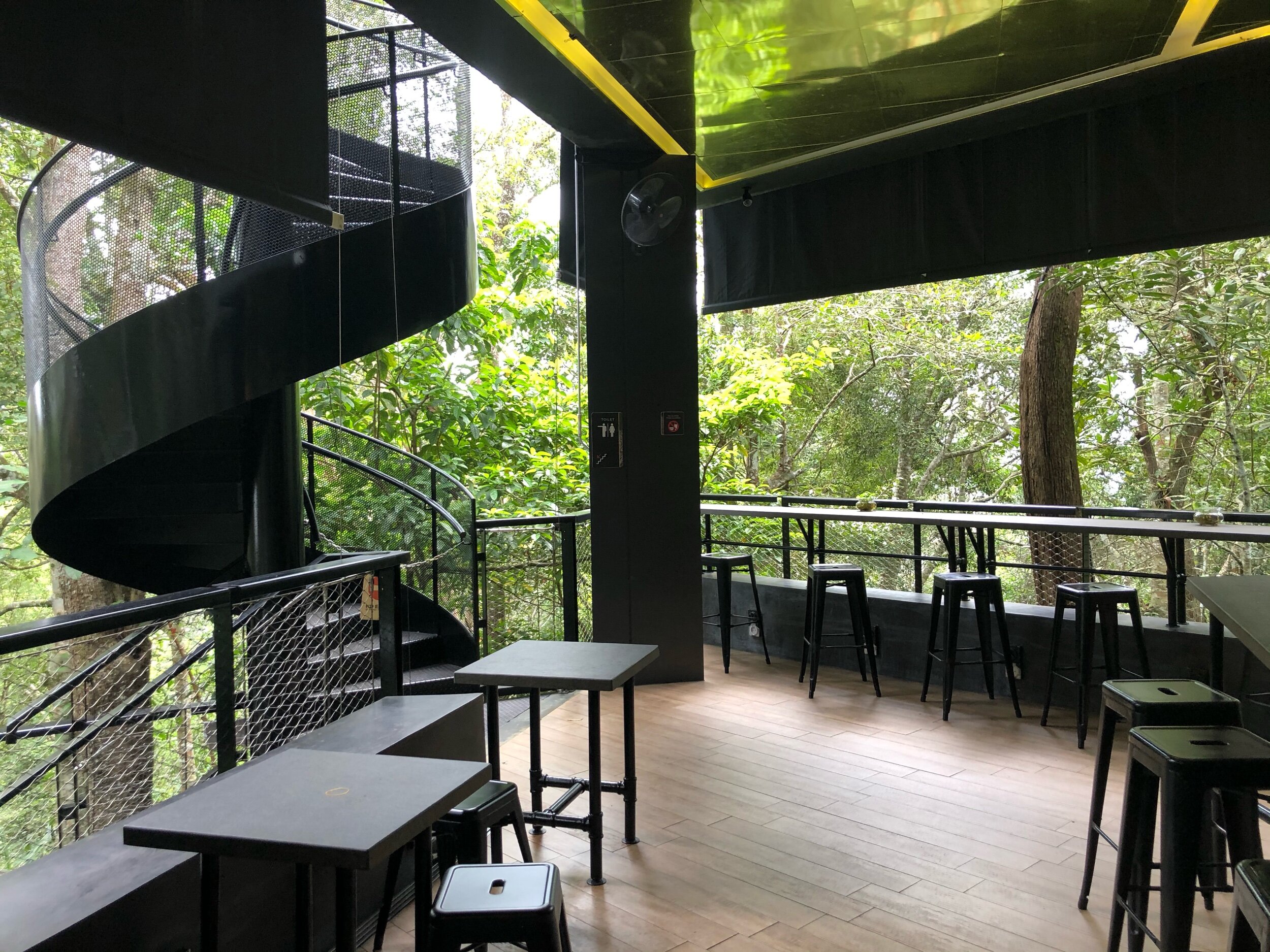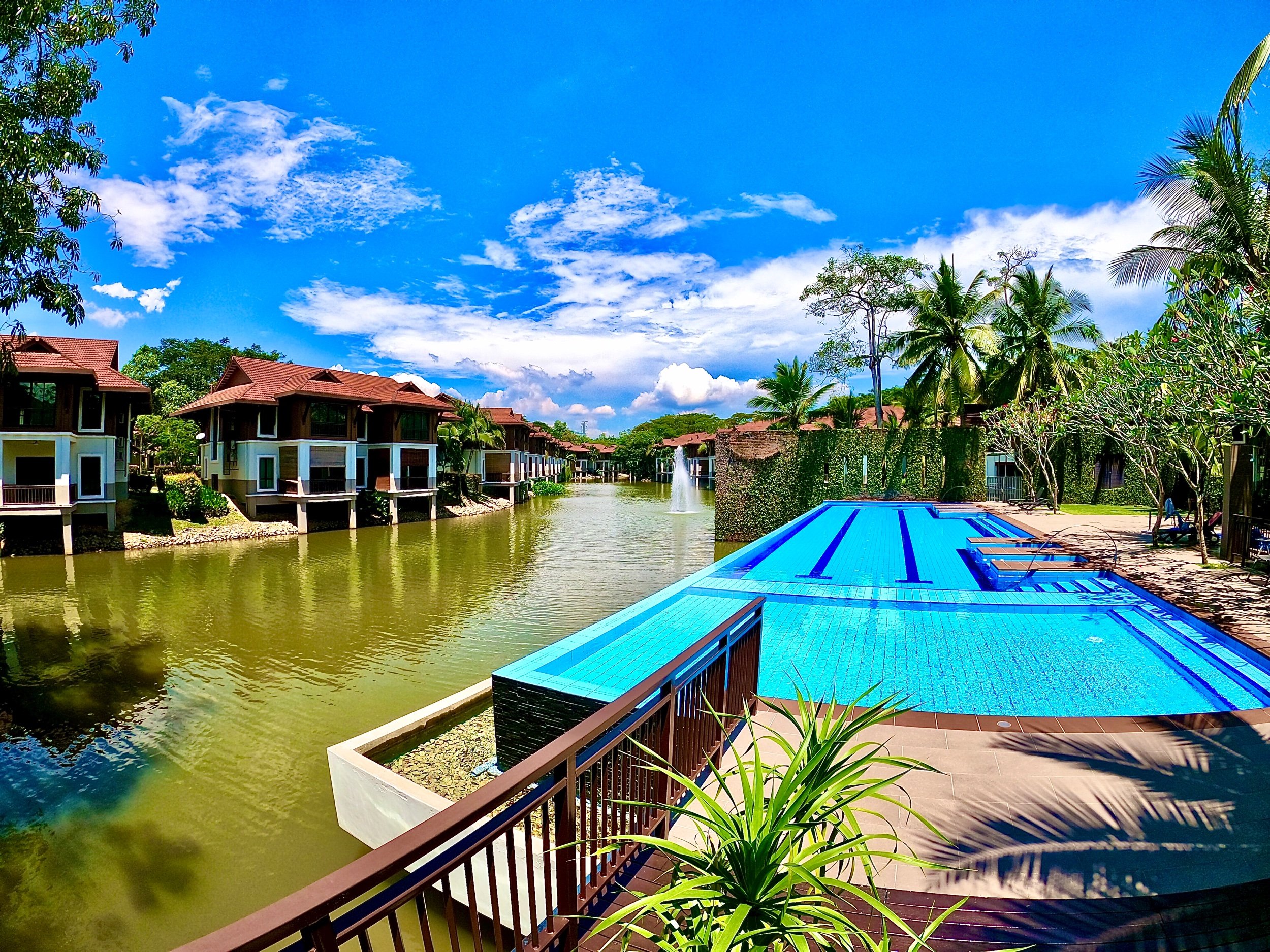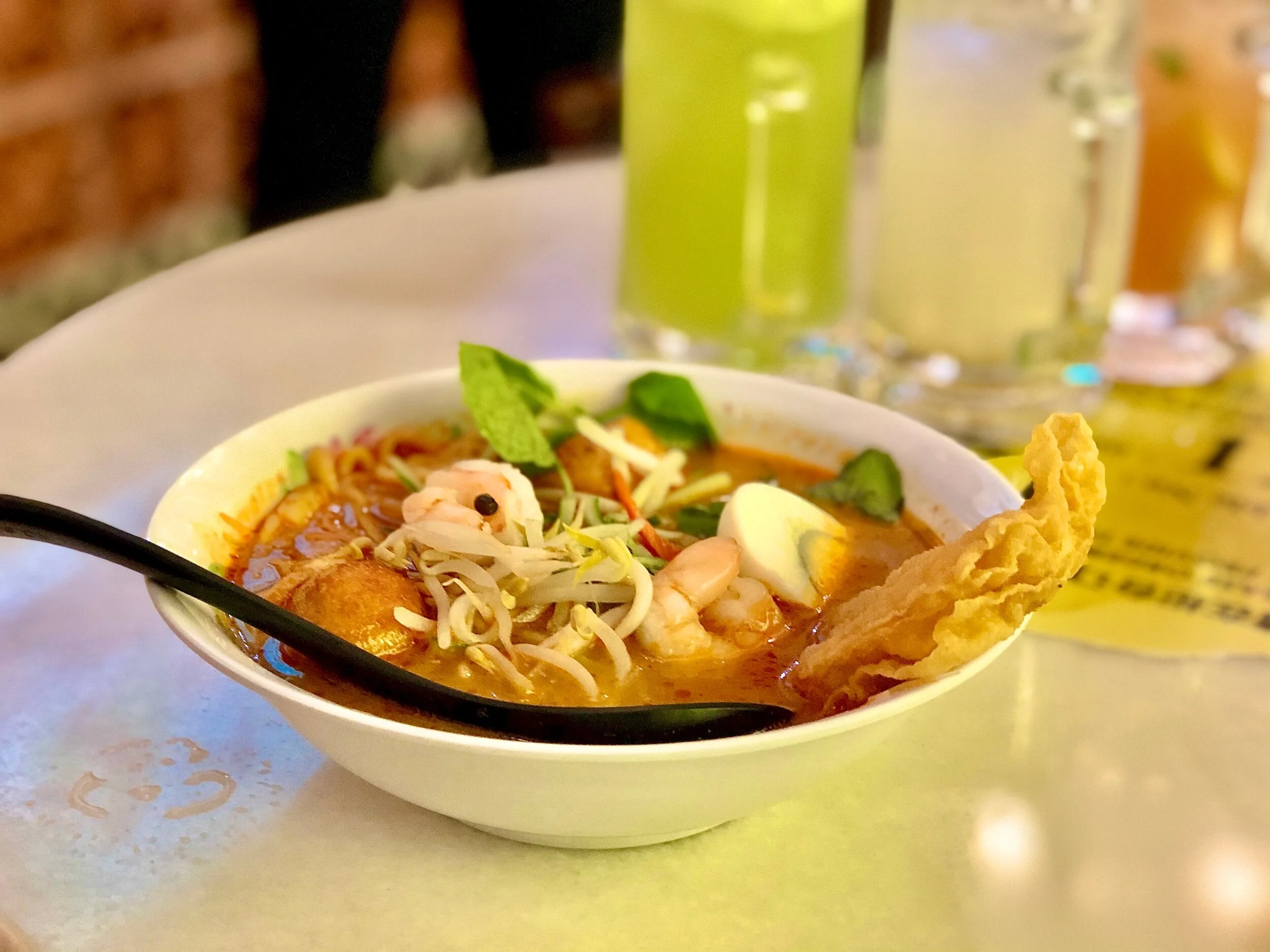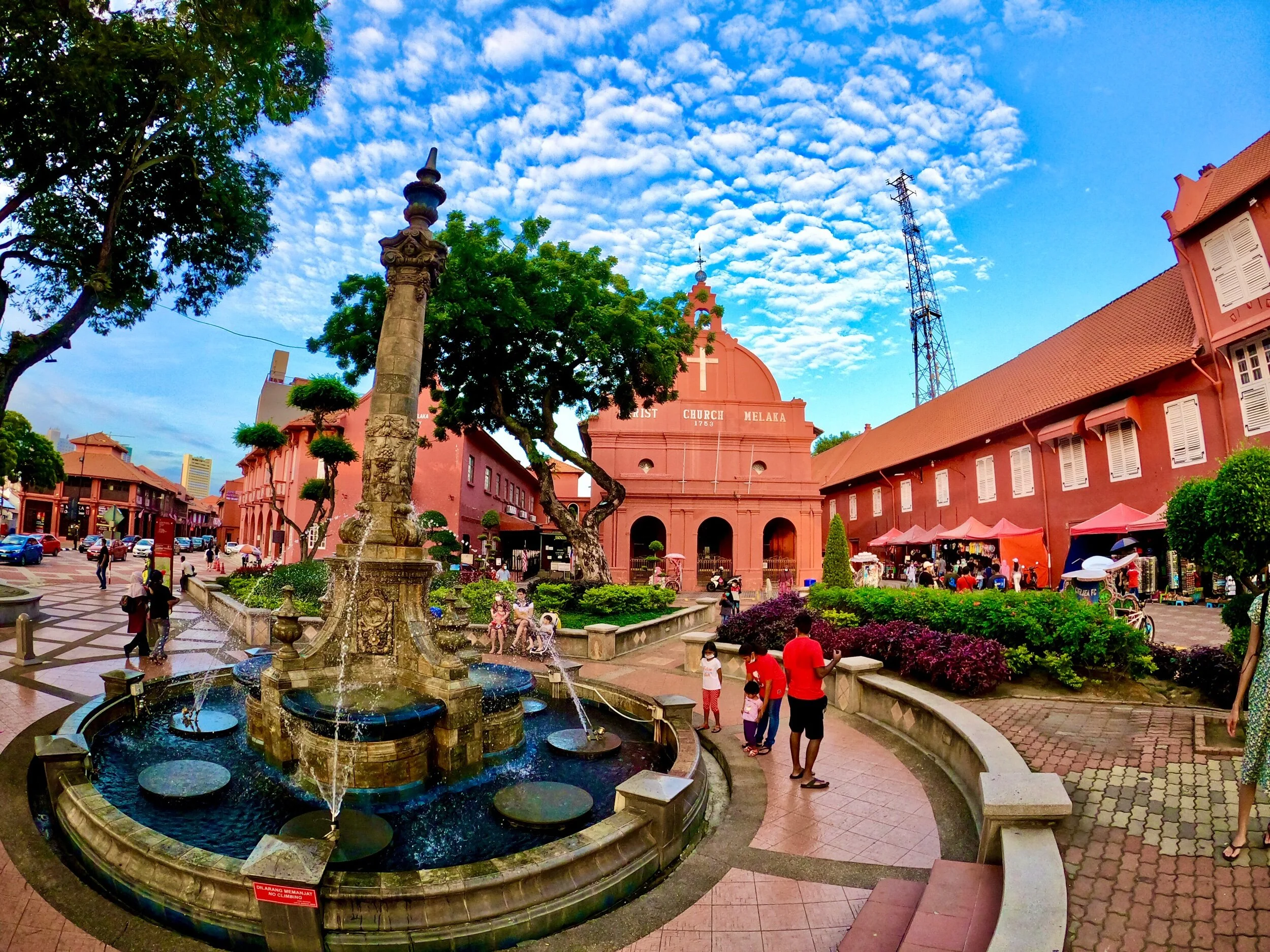The Habitat - Rainforest Ecotourism in Penang, Malaysia
Please note: This post may contain affiliate links. See our disclosure to learn more.
Destinations > Asia > Malaysia > Penang > The Habitat - Rainforest Ecotourism in Penang
MORE OF MALAYSIA: Kuala Lumpur, Penang, The Habitat, Historical Malacca, The Lost World of Ipoh,
Cameron Highlands, Johor Bahru, Delicious Straits Recipes, and Johor Bahru to Singapore
What is “The Habitat” at Penang Hill?
When we heard about the Habitat while we were in Penang, Malaysia, we looked it up on YouTube and Google to see what we could find. For the most part, there wasn’t much information out there about it - so, we didn’t know what to expect. At first, we thought it might be more of a rainforest exhibit that was inside the large structure known as the Curtis Crest Tree Top Walk.
It turns out that “The Habitat” was exactly the type of experience we had been searching for in Malaysia - an “authentic, diverse and educational rainforest experience” that left us feeling more alive than when we arrived.
Before we get into the details of what makes The Habitat so amazing - the highly recommended Forest Bathing experience, the Kancil Walk, the Langur Way Canopy Walk, the 13-meter high Curtis Crest Tree Top Walk, and the Flight of the Colugo - it’s important to take a step back and truly understand a little bit more about this special place. The Habitat not only has a rich history, but it is also very future-focused as well.
RECOMMENDED: Grab your Essential Guide to Malaysia’s Customs and Culture before you go!
Caring About the Future of the Planet - Eco-Tourism
The Habitat Foundation supports organisations and people working on research, management and conservation of plants and animals and their habitats.
The Habitat and The Habitat Foundation support, and help fund, efforts to safeguard biodiversity and protect the natural environment. One such example sits just outside of Penang Hill - the nomination the “Penang Hill Biosphere Reserve” under the UNESCO Man and the Biosphere Programme.
The Penang Hill Biosphere Reserve, which includes Penang National Park, consists of important natural habitats, 2456 species of plants from 206 families - 20 of which are on the IUCN Red List, including four that are listed as Critically Endangered - and more than 550 animal species.
The History of the Habitat
In 1786, the British East India Company arrived in Malaysia and purchased the State of Penang from Kedah. During the early 1800’s, they established the Straits Settlements - including Penang, Singapore, and Malacca - and making George Town, in Penang, the administrative and judicial capital.
The first plotted track to the top of the hill was completed in 1788, by Captain Francis Light, and began at the Penang Botanic Gardens waterfall. As Penang Hill was used as a lookout for incoming ships, it eventually became a spot for British colonists to avoid the heat in the George Town area, as the temperature and airflow at the top of the hill made it much cooler.
During that time, they built a 1.6 km nature trail at the top of Penang Hill, which has been mostly renovated and modernized throughout the years into what is now “The Habitat”.
Getting to the Habitat from George Town
Initially, to get to the top of the hill you would need to hike or ride a horse. However, to avail themselves of the 2-3 hour trek, a railway was attempted - the first attempt having failed in 1905 - and then completed in late 1923. It opened to the public in early 1924.
A major revamp at Penang Hill was initiated in 2010. The railway was overhauled, allowing for faster access to the hill, and facilities for visitors, walkways and viewing decks were constructed. [1]
Penang Hill Funicular
The easiest way to the top of Penang Hill, where the Habitat is located, is to take the Penang Hill Funicular Railway. This ride up the hill is 1.25 miles and takes about 5-10 minutes total.
When we went, the round-trip ticket was RM 30 per adult (babies 0-3 years old are free, children from 4-12 were RM 15). You can check out the current ticket prices here: Penang Hill Tickets, however we recommend buying your tickets in person or as part of a tour as you never know how the weather will change by the time you get there and/or if you’ll want to alter your plans (if it’s pouring rain).
RECOMMENDED: Start your adventure with a round-trip ticket and English High Tea at the best historical Colonial Restaurant on the hill, David Brown’s - and don’t worry, you’ll be able to spend as much time at The Habitat as you’d like after High Tea!
Hiking Trails
Alternatively, there are a number of trails that you can take to the top. The most popular are from the Lower Station, the Botanical Gardens, or the Moon Gate. However, the path can be steep and unconventional at times, and it typically takes the average person about 2 or 3 hours to leisurely hike to the top. Check out a list of the trails on the Penang Hill website. If you’re really interested in the history, try out the original path from the Botanical Gardens waterfall - you'll find the trail at the west end of the Botanic Gardens near a large water reservoir and it'll come to the waterfall quite quickly.
“Some of the more famous pit stops at the mountain are 52 and 84. At these pit stops, a view of the island is visible to hikers, who are able to get some water and tea prepared by locals stationed on the hill. Eighty Four is the last pit stop before the top of Penang Hill—approximately forty-five more minutes from 84.” - Wikipedia, Penang Hill
The Habitat Entrance Fee
Standard Entrance
Entrance into The Habitat to walk around on your own. Guide and funicular train ticket are not included. [see standard ticket prices here]
The Kancil Walk
A private guided nature walk at The Habitat - maximum of 8 persons per group. Guides speak English or Chinese and will explain the history of the Penang Island hill station and point out interesting, and hidden, flora and fauna along the way. Check out the summary of our Kancil Walk below! [see Kancil Walk ticket prices here]
RECOMMENDED: The Kancil Walk with lunch at the best restaurant on Penang Hill, the British colonial-themed David Brown's restaurant!
Forest Bathing Experience
This experience is a guided “forest bathing” through The Habitat, and our favorite part of this location. Included in the price is the guide, a “fast-lane” round-trip ticket on the funicular to the top of the hill, and an organic tea and fruit refreshment. Maximum group size of 6 people. See our write-up of this experience below! [reservations required]
*The Art of Forest Bathing originates in Japan.
Flight of the Colugo
Enjoy a flight on an 80m tandem zipline high above the rainforest. Then, continue on with the “fun course” - which includes an additional 4 ziplines, 1 rope bridge and 1 abseil. It’s an aerial adventure that you won’t want to miss - see our adventure video below! [reservations required]
Sunset Walk
This journey starts with a Kancil Walk that ends at the Curtis Crest Tree Top Walk just in time for sunset. Next, you’ll be guided, by lantern light, through the nature trail at night. [see our recommended tour below to get this special night experience]
What makes The Habitat so amazing?
1. Forest Bathing
A well-known phenomenon in Japan, known as Karoshi, literally means "death by overwork." The major medical causes of karoshi deaths are heart attack and stroke - due to stress and a starvation diet - and suicide - due to simply being overwhelmed for too long.
To "heal” their people from these stressors, Japan research teams came up with shinrin yoku - "Forest Bathing" - which has become the standard preventative medicine for people suffering from overwork stress, and part of Japan's National Health Program, since 1982.
Forest Bathing actually works wonders.
Sadly, this method hasn't been picked up everywhere around the world quite yet. However, if you find yourself in southeast Asia, there is a place you can do it in Malaysia.
Head up to The Habitat at the top of Penang Hill, located just next to Penang Botanic Gardens and Penang National Park, and try out an amazing Forest Bathing experience for yourself.
They begin by giving you a lemongrass citronella spray upon entry, to keep the insects away and open up your senses, and then they sit you down - in one of the very same spots that Jane Goodall stopped to share her Beacon of Hope - and give you a short history of why and how Forest Bathing works to reduce stress and bring your body and mind back to balance.
Look
It's not every day that you find yourself examining the plants and the trees with a magnifying glass, but that's exactly what you'll do as part of your Forest Bathing experience at The Habitat to get closer to nature.
In this part you will take a closer, more intimate look at leaves and notice things you may have missed before - like the veins in the leaves, the hairs on the stems, or the fact that they are green on the surface but red on the other side.
You may look at the flowers in greater detail, or even find yourself wondering how small pieces of sand found their way into the surface.
Take your time... Appreciate the complexity and the beauty of nature... and forget about the worries of life for awhile.
As the "sight" portion of the Forest Bathing experience begins to conclude, we were encouraged to stop for 5 minutes to really take in the forest.
This included really focusing in on the forest itself, the trees deep in the distance, the fog rolling in, the plants nearby, the tiny things on the plants, and even the trees overhead. We really were in the forest, and we began to feel more like a part of it during that time.
Breathe
As we moved on to the next station of Forest Bathing at The Habitat, we paused a few times to learn more about what makes this rainforest so special.
Additionally, we were encouraged to really breath in the forest, smelling and tasting the crisp, clean fresh air. Like the cool smell after a morning rain, but with a pleasing woodsy scent and of new ferns.
Arriving at the "breathing" station, we laid down on some mats and looked up at the ferns above our faces and the birds flying between the branches in treetops above.
We then started breathing by using a modified Wim Hof method. While laying down, we would take 10-15 quick, deep breaths, inhaling through our noses and exhaling through our mouths.
Then, we would take a deep breath and exhale; then hold as long as we could until we needed to breathe in. Next, we'd inhale again, as deep as we could, and hold that for 10 seconds. We did this for about 10-15 minutes, but it did feel like longer!
To be quite honest, it was a little exhausting, but it left us feeling less stressed in a way that I can only describe as the feeling you have after a very long run (10k+) - or if you're unfamiliar with that feeling, kind of like taking a strong pain reliever and/or stress reducer... only it was natural and healthy!
Listen
Slowly walking onward, we began our listening exercise.
Hear the tweeting of the birds, buzzing of the bees, rusting of the leaves, the whooshing and eolian sounds of the wind, and the rolling flow of the water.
Specifically in this rainforest, you can hear the drumming call of woodpeckers, the loud, high-pitched buzz of male cicadas, the bubbly notes and grunts of Malaysian giant squirrels, the whistle tweet of the Asian fairy bluebirds, and the squeaking of spectacled (dusky leaf) langur monkeys.
Listen to them one by one, focusing on on each of them separately until you are hearing only that one sound. Then let in a second sound, then a third. Continue until you hear the chorus of this rainforest.
Smell
After the breathing exercise, we move onward to stimulate our sense of smell - passing by a large granite boulder on the way, feeling it, and learning it's importance to this amazing island.
Upon arriving at the aromatherapy enclave, we take a seat while the guide lights up the tea tree oil diffusers - which create a calming and relaxing atmosphere.
Next, we are given a coffee bean and napkin that we can use to help cleanse our hands and nose from the upcoming scents.
We are told to close our eyes as unique leaves are placed into our hands from a basket, then we are to roll them, or crush them, to bring out the smells and sniff in their aromas.
One at a time, cleansing with the coffee bean and napkin each time, we are introduced and awakened by the smells of ylang ylang, pandan, cumeric leaf, culantro, and coliman lime leaf.
Waiting for each new scent is exciting and informative as we are looking forward to what is next while being told about the importance of each leaf to Malaysian culture and the rainforest around us.
We come out of it with a greater respect and appreciation of the plants we see growing around us as we pass through the trails.
Feel
Being in a rainforest on top of a mountain already gives you a calming sensation.
But each part of the forest bathing focuses your senses and immerses your experience in nature.
To further the “touch” experience, we were invited to remove our footwear and walk along a slightly overgrown moss-covered walkway.
The guide said the walkway isn’t usually covered in as much moss but because there weren’t any visitors during the stricter part of MCO, nature was starting to take over.
Everyone in the group appreciated the softness of the moss compared to the asphalt walkway as our feet weren't accustomed to stepping on the occasional loose rock.
Each step was to be taken in a sort of meditation – noticing which foot you were stepping with, the direction you were going, how it felt as your foot hit the ground, etc. Taking each step with purpose and focusing on where you were at that moment with no other distractions.
There’s something to be said about being present and letting your mind push any other thoughts/worries/stressors aside.
The guide also pointed out a few plants and had us examine different textures of leaves through sight and touch. It’s definitely helpful to have a guide instruct you which plants are safe to touch!
After the short walk barefoot, we put our shoes back on and headed to the platform. Our guide taught us a little about the age of some of the walkways and staircases, and it was fascinating to learn about the history of the area.
The guides we spoke to all seemed to genuinely love working at the Habitat and their eyes would light up as they spoke about the history, the foliage, and all the animals big and small that call that area of Penang Hill home.
Taste
At the platform, there were some mats set up for the “taste” portion of forest bathing. The guide informed us that he was part of a team that selected each portion of the taste experience. Each food had a specific taste experience it targeted – bitter, sour, salty, sweet – and we were guided to focus our minds on that one taste.
We were also treated to a Chinese tea ceremony and the guide explained each step of the ceremony in detail. There was a specific purpose behind each step and it showed the careful thought process behind what many of us would think to be a simple task to make and serve tea.
There was a short debriefing session after the tea ceremony. Each person in the group shared their overall impression of the forest bathing experience and their favorite part. Everyone seemed to have very positive feelings toward the whole experience with many expressing interest in doing it again.
Whether you’re overly stressed and needing to do something to relax, or just interested in learning more about nature and focusing on being more present in the moment, we’d highly recommend trying out Forest Bathing at the Habitat.
2. The Kancil Walk
The Kancil Walk at The Habitat isn't just a guided walk through the rainforest. It's an in-depth description and understanding of the forest that you're walking through with the added benefit of an expert pair of eyes that knows where all the special wildlife is hiding.
The Langur Way Canopy Walk
You'll cross over the Langur Way Canopy Walk, which "is designed and engineered to be ‘tree friendly’ without rigging any of the steel cables directly onto the trees."
From here, you'll be able to see all the way to the forest floor from up in the higher parts of the trees, spotting things like Asian ferry blue birds, Giant Malaysian Squirrels, and even Langur Monkeys!
Take a break at one of the giant swings and admire the butterflies, the sound of the various animal species, and the amazing views of the rainforest.
Curtis Crest Tree Top Walk
Not far from the Langur Walk bridge, you can make your way up to the Curtis Crest Tree Top Walk, which is the highest public viewing point on the island. It was designed to give visitors an intimate experience of the forest, like walking on the very tops of the trees, whilst also allowing unobstructed views of the entire island from nearly 800m.
On our "Kancil Walk" experience, our guide shared with us the magical history and importance of each spot to bring our minds on a journey through time - something we surely would have missed without her, as well as pointing out so many different types of fauna and flora that we'd also likely have overlooked.
She also explained how careful they were in designing The Habitat so that it wouldn't hurt the plants and wildlife. It's definitely worth a few extra ringgit!
3. Flight of the Colugo
The Flight of the Colugo is The Habitat's adventure zip line course. If you enjoy rainforests, and the fact that The Habitat uses environmentally friendly structures that don't harm the trees, perhaps this is the zipline course for you.
Consisting of 5 zip lines, 1 abseil and 1 rope bridge, you'll fly through the rainforest like the flying lemur - aka the "Sunda Colugo" - spotting the unique plants and animals while soaring from platform to platform.
Additionally, you'll cross a rope bridge high above most of the other tress and see straight through to the valley below.
Abseil down the side of one of the taller trees like Tarzan, or James Bond, and feel the thrill of the rainforest as you descend back into the Habitat below.
What an experience!
4. Cafes & Gift Shops
The 2 cafes are located at the beginning and near the end of The Habitat.
You will find an assortment of baked goods, sandwiches, single serve pizzas, muffins, cakes, coffees, teas, and even a few beers! The atmosphere is quite relaxing and the prices are fair. We really enjoyed the beverages, and might recommend the cafe at the front for more food options - or grab lunch at the famous Colonial Restaurant, David Brown’s, before your entry.
While the Cafe at the entrance has a few souvenir items for sale, just about all of the merchandise is located at the cafe near the end, which is also the gift shop. Don’t forget to pick up a little memento - you’ll be pleasantly surprised by the prices!
Are you planning to visit The Habitat?
The most convenient location would be Guesthouse Hickory which is located right outside of the entrance on top of Penang Hill and rated over 9/10. This is the one that we would recommend.
A great alternative to Guesthouse Hickory is the Bellevue Hotel, also on the hill. For hillside camping and bunk-bed rooms, look at the Hillside Retreat.
For budget travelers, the Good Luck Inn at the bottom of the hill is a fairly good option - but we also recommend checking out these amazing bed and breakfasts!
Restaurants
Once you are all checked into your room, head out and try some food from the various food carts or restaurants on the hill - the best one is David Brown's.
Alternatively, don't miss the Bellevue Restaurant - which is located at the Bellevue Hotel and is another historic Colonial era restaurant!
Thank You VERY Much!
Thank you VERY much for reading our article. We actually created this website to help people reach financial independence. Did you know that by having a remote job and traveling endlessly, or living in a country that has low costs of living, you can actually reach retirement quicker? Plus, retirement abroad is up to 75 percent cheaper as well! Learn more by exploring our website: EatWanderExplore and REmotiFIRE.
See our Thank You page to sign up for our free weekly newsletter - you’ll receive only 1 email per week letting you know about our latest travel articles, remote-work life, and amazingly affordable destinations!
Found this post useful? Buy us a coffee to help support this site’s running costs OR share this article with a friend.











































































